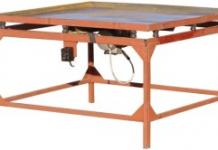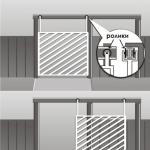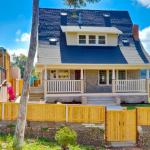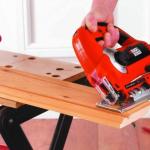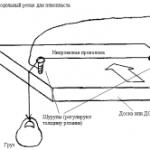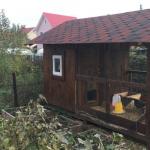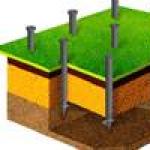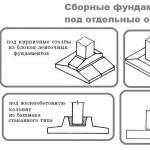You can easily build a garden house with your own hands. To do this, you do not need to install a complex buried foundation. Yes, and you can get by with the tools that you find on your country plot.
Selecting a location
Initially, it will be necessary to determine the location where construction is planned to take place. The house should not be located in a low area where water will accumulate, as this will significantly shorten the lifespan of the building materials. It is best to choose the highest point of the site. Experts recommend locating the house in the northern or northwestern part of the territory.
Preparatory work

It will be impossible to build a garden house with your own hands if you do not prepare the appropriate materials and tools. The first ones can be brick, as well as gas or foam block. If you want to speed up construction, it is recommended to prefer aerated concrete. Products made from it, as a rule, are of considerable size.
Load-bearing structures can be erected from pine timber, which has a square cross-section. Its side should be equal to 100 millimeters. One of the four sides of the timber, which will form the outer surface of the wall, must be planed. The edges of the material must be chamfered. The remaining elements of the building, namely the ceiling, rafters, windows, floor beams, and windows can be made using pine timber.
Material selection

A garden house with your own hands should be built exclusively from well-dried material. It is important that the moisture level of the wood is the same, otherwise uneven deformation may occur during shrinkage. In addition to wood, you should prepare insulation material, antiseptic impregnation, nails, plaster, asbestos cement sheets, construction foam, and floor slats. It is important to have the entire necessary set of tools: a hand-held circular saw, a drill, an angle, a cord, a brush, a ruler.
House construction technology

If you decide to build a garden house with your own hands, you will first need to mark the area. Afterwards, excavation work is carried out. The depth of the foundation should be determined depending on the type of soil and the freezing line. The level of groundwater is also important. The foundation must be laid below the frost depth. The most suitable soils for installing a foundation are silty sands with clay, wet clay soils, and peat bogs, which require laying a sand cushion. The layer of the latter should be equal to 20 centimeters.
After the trench for the foundation is dug, the walls and bottom must be compacted well, which is true if you plan to build a strip-type foundation. It is suitable for heavy walls made of brick, stone and concrete. If the construction will be carried out using wood, and the soil is characterized by a significant freezing depth, a columnar base should be used. Natural stone, concrete or rubble concrete are often used for the foundation. Below the waterproofing layer, experts recommend using concrete grade M120-150. You can use clay brick grade M75 or cement mortar labeled M25-50.
Waterproofing

Between the foundation and the walls, waterproofing must be laid, which is located 15-50 cm from the ground surface. Rolled waterproofing materials can be glued to the surface of the foundation using hot mastic. There should be a blind area around the base, which is a strip 80 cm wide, but no less. This element must be performed using clay. However, you will first need to get rid of the top plant layer of soil. Gravel or crushed stone should be buried in the clay, after which everything is covered with fine-grained asphalt.
Features of wall construction

When building garden houses with your own hands, it is important to follow the technology of the work. Initially, rough timber is laid on the surface of the foundation in one row along the perimeter, which will create the outline of the walls of the building. The elements should be fastened together with nails. The frame is based on four pillars that need to be installed in the corners. They are dug into the ground, and then fixed to the rough timber with the lower part. It is necessary to fasten it from above using temporary braces, which must be set vertically.
Completion of the walls

It is recommended to use long nails to secure frame elements. Once the frame becomes rigid, it can be lined on both sides. In advance, it is necessary to lay the timber blanks between the edges of the corners. They are attached to each other with 150mm nails. Linen tow is laid between the beams. During the construction process, it is imperative to check the position of the elements using a building level.
Floor arrangement
When garden houses are built with your own hands, the beams of the first floor are laid on the surface of the strip foundation. A subfloor should be laid on top, the basis of which can be an edged planed board. Due to the fact that such material dries out after losing moisture, it is necessary to make a clay screed on the floor, placing insulation on its surface. It is recommended to cover the subfloor with a layer of roofing felt. It is better to use mineral wool boards as insulation material. The top of the insulation is covered with a second layer of roofing felt. Then a cement-sand screed is poured, the thickness of which should be 2 cm. Ceiling beams made of timber play the role of a frame, which is necessary for the ceiling floor of the first floor. This overlap can be done using planed edged boards.
Floor arrangement
Before you build a garden house with your own hands, you need to stock up on sawdust, which will fill the space between the floor of the second floor and the ceiling of the first. Afterwards, the ceiling must be covered with clapboard, which is done in parallel with the improvement of the walls. After drying has been carried out, the floor of the second floor, if there is one in the house, must be improved with a floor lath. It should be laid perpendicular to the subfloor. In this case, it is necessary to use the technology of forced compression of several planks, using wedges for this. This technique will reduce the gaps in the floor, which will certainly form after the lumber has completely dried.
If the house has a fireplace or stove, the section of the floor that is adjacent to such equipment must be made of ceramic floor tiles. Moisture-resistant plasterboard should be laid on the subfloor. Ceramic tiles are laid on top.
Roof arrangement
If you are building a garden house with your own hands, the step-by-step instructions presented in this article should help you carry out the work. Attic floors are made using a similar technology. The ends of the beams will rest on the load-bearing walls. They should be cut into the top trim. If you have to work with walls that are made of brick or stone, you need to make nests in them. Their back wall must be covered with a layer of felt, which is pre-impregnated with resin. In those places where the beams rest, you need to lay a layer of roofing felt or roofing felt. Before you build a garden house with your own hands from timber, you must remember that the roof of the building will consist of an outer covering and rafters, the latter being inclined supporting beams. They have a decking or sheathing system on them.
Due to the fact that a garden house is a fairly simple structure, it must have a single or gable roof. The slope depends on climatic conditions and the material at the base of the roof. The more precipitation falls in the region, the steeper the clone must be made during construction. If you are building a garden house with your own hands with a veranda made of timber, then it may have asbestos-cement sheets as part of the roof. You can use tiles or sheet steel. When installing rafters, it will be easiest to mount them in an inclined position. In this case, the rafter legs should be cut into the upper frame of the walls. They can also be embedded into the Mauerlat. It is mounted around the perimeter at an acute angle.
It is necessary to make sure that the cross-section of the Mauerlat is at least 100 x 100 millimeters. When building garden houses, how to make such structures with your own hands? You should definitely ask a specialist about this.
On top of the rafters, for example, you should install a lattice made of boards and poles. They must be nailed staggered or close, installing parallel to the ridge. The sheathing on the roof overhangs should form a continuous deck. If you have chosen the most efficient asbestos-cement sheets, they need to be nailed to the roof, or more precisely, to the sheathing, the elements of which were installed in increments of 530 millimeters. If you are building a garden house with your own hands, the construction instructions should interest you. The algorithm of actions presented in the article will certainly help you.
Conclusion
If you are building a garden house, then at the roofing stage the asbestos-cement sheets should be installed in such a way that the sheets overlap the width of the wave in the horizontal direction.
The sheet that is located above must be lowered onto the underlying one by about 120 millimeters. Asbestos-cement elements with a slight roof slope must be laid on roofing felt sheets. This must be done overlapped and parallel to the ridge. Each side of the sheet should be secured with four nails. As an alternative fastening solution, screws can be used. It is important to follow the technology of the work; this will guarantee 50 percent of success. Before starting the process, the master must also take care of choosing high-quality materials, since the durability of the building will depend on this.
The dream of many city dwellers is a beautiful small house outside the city, where they can escape from the hustle and bustle of the city, hide from the heat, and feel the pleasant freshness of the earth under their feet instead of hot asphalt. But not everyone’s dreams come true; it seems that a country house is complicated, expensive, and time-consuming. In fact, building a country house with your own hands is quite simple.
Planning the space
Choosing a location for a future country house is not the time for hasty decisions, because there is not that much space. Thoughtful, competent planning will help you use every piece of land as efficiently as possible. Even though this is your land, you will have to fulfill a number of requirements, maintaining a minimum distance:
- from the street – 5 m
- from the passage – 3 m
- from the neighboring plot - 3 m
We are not considering the option with a low area - water will accumulate there. Optimally, the highest place on the site is in its northern (northwestern) part.
Projects of small country houses
Considering typical designs of country houses, it is easy to notice that the undisputed favorite is a one-story building with an attic. This is a time-tested option for a country house, but you can dispense with the utility unit, because equipment and household supplies can be stored in the attic.
You can add a terrace to the house - in summer it can be used as a dining room. Two-story country houses often obtained without actually constructing a “clean” second floor, having arranged instead attic. Then on the ground floor you can plan a kitchen and living room, and the second floor - for the personal space (bedrooms) of the owners.
Advice! You can save significantly on the heating system - even at the most modest prices for installing a classic one (boiler, pipes and radiators) accounts for 15-20% of the total budget. If you are building a small country house with your own hands, where you plan to live only during the “season” (late spring - early autumn), then to heat it in bad weather, you can get by with electric or infrared heaters.
Prefabricated country houses are becoming very popular - unpretentious, outwardly monotonous parallelepipeds with roof We replaced architecturally interesting buildings with an improved layout, one or two floors.
You are buying a kind of construction kit; such a country house can be easily erected with only basic knowledge about construction. The main thing is that it already includes all the systems - electrical wiring, ventilation, air conditioning, plumbing. This will help avoid many mistakes that beginners make when they decide to build a country house with their own hands.
A prefabricated country house is designed for a long holiday with family or friends; it is larger in area, can be one or two floors, with an improved layout. Such a house is equipped with a technical room, a kitchen, rest rooms and a bathroom, equipped with a heating, ventilation, air conditioning system, and supplied with electricity.
The house can be equipped with a water heater, sink, countertop, hanging shelves, shower cabin, necessary plumbing. After installing such a country house, no additional repair work is required; it is completely ready for use.
Laying the foundation
The choice of foundation type is directly related to the choice of material from which the house will be built, as well as the number of storeys. Light houses (from rounded wood, timber, frame houses and modular) can be erected on a columnar or screw foundation; heavy (brick, aerated concrete, stone, concrete blocks) and two-story houses will require the laying of a strip foundation (as an option - a prefabricated one, made of reinforced concrete blocks) along the entire perimeter and under the load-bearing walls of the house.
It is important to know the depth of soil freezing - the foundation should be laid below this level, taking into account the level at which groundwater lies.
In the basement part it is required to install waterproofing at a level of 0.2-0.5 m from the ground. If the soil is dry enough (sand), a cement-sand screed 2-4 cm thick can be used as a screed. For wet soil, roofing material will need to be laid on top of such a screed - in two layers. As an option, roofing felt can be glued onto a dry screed using hot mastic. Waterproofing is installed below the expected level of laying the floor beams.
Advice! In the basement, to ensure ventilation of the subfloor, small holes are made, which are covered with a protective mesh.
A blind area is created around the base, its width is at least 70 cm (it should protrude further than the overhang of the cornice), with a slight slope directed from the walls of the house. To do this, the top layer of earth is removed, clay (sand) is poured, a layer of crushed stone (gravel, broken brick) is poured on top of it and filled with concrete (rolled with asphalt).
Floor and walls
Flooring begins with laying joists. To insulate the floor, insulation is laid between the joists, on top of which a vapor barrier is laid. It is attached to the joists with a stapler, and the joints are taped. Then the subfloor is laid, for which they use an unedged, cheapest board, having previously treated it with an agent against dampness and rot. And only then the finished floor is laid out. In a two-story house, the frame for the floor on the second floor is the ceiling beams of the first.
Every person who has purchased a small plot of land for a summer cottage strives to build a house or a similar easily erected structure in a short time. To have a place to relax after a hard day at work, or to hide from inclement weather. Well, it’s natural to get settled in everyday life. Of course, it is advisable to build a house so that it can accommodate the whole family and guests who come for the weekend. The task is, of course, enormous, but quite doable if you have accumulated savings to build a country house, because a large amount of new building material will be required.
If possible, you can hire hired workers to build this structure.
Of course, this will significantly increase financial expenses for your family, and if this is not possible, you will have to build a country house with your own hands.
Mostly, dacha owners build their houses with their own hands in order to save money on hiring a construction team and invite relatives and friends to help with the construction, which naturally reduces the cost of the construction process.
Summer residents also sometimes use used materials, which can be purchased at half the price compared to market prices, but this will reduce the durability of the structure by half.
When building his country house, the author decided not to skimp on the basic material and buy everything on the construction market so that it would last for a century and the house would last a long time, delighting his family and his guests with its comfort and aesthetic appearance.
The main material for construction was, of course, wood, which could be better and more beautiful than wood. The author purchased bars and boards at a local sawmill, which turned out to be much cheaper than in a hardware store.
When starting construction, I first drilled holes for the supporting pillars, inserted them and filled them with cement mortar. I tied the poles with boards and left them for a day for the solution to dry. Then he began construction, step by step moving towards his cherished goal.
And so now let's take a closer look at how he built his country house, and what he needed for this.
Materials: board 30 mm, timber 100 by 100, timber 40 by 60, floorboard 50 mm, insulation, professional sheet, lath, fiberboard.
Tools: circular saw, drill, drill, screwdriver, hammer, shovel, electric plane, angle, ruler, tape measure, circular saw.
And so the first thing he did was invite his neighbor and together they drilled holes to install the pillars.

Then I installed the posts and filled the holes with cement mortar.

I made a screed at the bottom and top so that the pillars would stand level, and after a day, after the solution had gained hardness, I began further construction.

The author makes the top harness.

Then he moves on to creating the roof ridge.









Next he makes the roof sheathing.



Shows the rafter attachment point.

The remains from sawing will also come in handy somewhere.

Next, he proceeds to installing the roof from a professional sheet.





Then he moves on to installing the floors of the house.







So we have a place to store boards from precipitation.

Prepares a batch of boards, cutting them apart on a circular saw.


And begins finishing the cornice.


She covers the walls with boards, and seals the gaps between the boards with slats.

Next we move on to the ceiling trim.
Having bought your plot outside the city and decided to build a summer house on it, you will be faced with many questions related to the choice of layout, selection of suitable materials and construction. However, you have one advantage - it is much easier to build a small summer house with your own hands than a solid mansion with a complex layout. Thanks to our tips and step-by-step guides, you can build your own house by choosing a suitable photo of the future structure on the Internet. Such a house will become any vacation spot for the whole family and will not require significant financial investments from you in its construction.
Features and differences of the flight house
As a rule, a summer house is a compact one-story building or a building with an attic floor. However, even a small country house should have all the conditions for a comfortable pastime - a kitchen, rooms, a veranda, preferably a water supply with sewerage. As for the bathroom and shower, when building a country house, which is designed for living in the warm season, you can get by with a separate toilet and a summer shower on the site.
Unlike a full-fledged country house, inexpensive and lightweight building materials are usually used to build a summer house, which can be installed with your own hands without the use of construction equipment. Another advantage of using such materials is the ability to build a shallow, light foundation. This way you can save on both materials and the volume of excavation work.
Tip: for the construction of summer houses, the optimal material is wood. Installation is best done using frame technology.
Country house project

On the Internet you can find many photos of country houses, from which it becomes clear that this building can have completely different dimensions, design and layout. The choice of one option or another depends on the size of the dacha plot, the number of people who will live in the house, and financial capabilities.
If you look at the layout diagrams of summer houses, you will notice that their sizes usually do not exceed 5x6 m or 6x4 m. Larger houses are built for the purpose of year-round living.
When designing and building a country house with your own hands, you should think about its correct placement on the site. When choosing a site for a house, you should observe the following regulatory gaps:
- The building should be located at a distance of at least 3 meters from the border of the neighbors’ territory. From the border of the site, which runs along the street or driveway, the house should be located at a distance of at least 5 meters.
- It is also worth observing fire breaks from residential buildings in neighboring areas. These gaps depend on the materials from which both structures are made. So, between two stone houses there should be a gap of 6 m, between a stone and a wooden house - 10 m, between two wooden houses the distance should be at least 15 m.
- Distances from outbuildings on your site to the house being built are not standardized.
Most often, a one-story building with a veranda or terrace is chosen for a summer house, where it is very pleasant to relax on quiet summer evenings. The veranda or terrace can be open or closed. An attic space is built under the roof of a one-story house, which can be used to store country utensils, garden tools, etc.
If the area of the plot does not allow for a larger structure, and in a small one-story house it is not possible to carve out enough space for all family members, then the best option would be a summer house with an attic floor. In the photos on the Internet you can see how beautiful and proportionate such houses look. At the same time, on the ground floor you can arrange a kitchen and living room, and the attic floor can be allocated for bedrooms for all family members.
Some owners of country houses dream of making a fireplace in it. This product will not only create a cozy family atmosphere on a quiet evening, but also heat the room on cool nights, which sometimes happen even in summer.
Advice: if you decide to make a fireplace with your own hands, keep in mind that you need to lay a good foundation for it. You can build a fireplace out of refractory bricks, but doing it yourself is very difficult. But installing a metal factory fireplace is quite possible.
Selection of materials

At the stage of choosing a layout, it is worth choosing in advance the materials from which construction will be carried out. To build a summer house, you can use the following products:
- The traditional material for building a country house is wood. It is distinguished by its environmental friendliness, ease of processing and installation, and affordable price. In addition, walls made of wood create a favorable microclimate in the room, regulating humidity and saturating the air with healing phytoncides. A wooden house can be built from timber, logs or sheet materials using frame technology. The only drawback of such buildings is their increased fire hazard.
Important: in order to protect a wooden building from fire, rot and damage by insects, the materials must be treated with special impregnations (antiseptics and fire retardants).
- A country house built of brick will cost much more, but it will be stronger and more durable. However, if such a house is heated or a stove is built in it, then the building can be used even in winter. The process of building a brick house is longer and requires you to have the appropriate skills, although if you wish, such a structure is also easy to build yourself.
- Foam blocks and gas blocks can be a cheaper alternative to brick. In addition to its reasonable price, this material has a low specific weight, which makes it easier to transport and install. A house made of aerated blocks is quite warm, but requires external cladding to protect the walls from moisture, since the material is quite hygroscopic. Provided a heating system is installed, you can also live in such a house in winter.
We should also talk about materials for arranging the foundation. Their choice depends on the design of the walls, the type of foundation, geological and climatic conditions in the region of construction. If we are building a house from piece stone materials (brick, foam blocks or gas blocks), then it is better to choose brick, concrete or reinforced concrete for arranging the foundation. So:
- Under a brick house you will have to make a buried monolithic strip foundation made of reinforced concrete. This is the most expensive option for arranging the foundation. The depth of the foundation base should be below the freezing point of the soil.
- For walls made of lightweight materials (aerated concrete, foam blocks and wood), you can install a shallow strip foundation made of monolithic reinforced concrete, a columnar base made of concrete, stone, factory blocks, steel pipes or processed logs.
- On heaving soils and when building on a slope, it is advisable to make the foundation on screw piles. They are made from steel pipes with a helical blade at the end. Pipes can be screwed into the ground manually. The depth of placement is below the freezing point.
As for the materials for arranging the roof, they are no different from those used in the construction of a traditional residential building. Wooden beams are used for the rafter system, the sheathing is made of boards or OSB (in the case of laying soft roofing material). The roof covering can be made of corrugated sheets, metal tiles, rolled flexible tiles, slate, etc.
Construction technology

Since the most inexpensive country house will be a frame building on a columnar foundation, we will describe step by step how to build such a house with your own hands.
- After preparing the site and marking, we dig holes for the pillars. It is worth noting that the pillars are made under all external and internal load-bearing walls with equal spacing (1-1.5 m). The dimensions of the pillar depend on the material from which it will be made. Brick pillars for a frame house can be 380x380 mm in size.
- After digging holes to a level below the freezing point of the soil, a sand cushion is placed at the bottom. A layer of sand 10 cm high is moistened with water and thoroughly compacted.
- Then pillars of the required height are laid out of brick using cement mortar. The outer surface of the posts is plastered.
- The upper horizontal surface of the pillars is waterproofed with two layers of roofing material.
- Next, the strapping beams (beams 150x15 mm) are laid on the pillars. In the corners they are fastened together and fixed to the posts using anchors or steel brackets.
- We attach logs to the frame beams at equal intervals (70 cm).
- Next we install the wall frame. It can be assembled on the ground and lifted onto a beam or erected directly on the harness. The second option is more suitable for doing it yourself. For the frame it is worth taking bars with a cross section of 50x150 mm. In the corners of the house, double bars are installed to increase rigidity.
- We install vertical frame posts at the location of window and door openings, as well as along the entire plane of the walls with equal spacing.
- After this, the upper strapping beam is mounted. Horizontal frame beams are fixed above the window and door openings. In the corners of the house, to increase the rigidity of the frame, oblique struts are installed on both sides.
- Now the frame of the house is sheathed with sheet material (OSB, chipboard, moisture-resistant plywood) or clapboard. In the space between the two layers of sheathing (inside the frame) it is worth laying thermal insulation material (mineral wool, basalt insulation, extruded polystyrene foam).
- Let's move on to the construction of the floor. We attach subfloor boards to the joists on the bottom side. On top of them, going around the logs, we lay a waterproofing membrane. Then we put insulation into the gap between the joists. After this comes a layer of vapor barrier and finished floor boards.
- We install floor beams above the vertical posts of the wall frame. For a tight fit, grooves are cut out on their edges. The beams are additionally fixed to the frame with steel corners.
- Now we are installing the rafter system. We fasten the outer pairs of rafter legs on the ground and mount them on the walls as gables. We connect these pairs of rafters using a ridge beam. After this, you can mount the remaining pairs of rafter legs and install them at equal intervals, connecting them to the frame beams and floors.
- Next, a vapor barrier film is spread over the rafters. It is fixed with brackets and counter-lattice slats on the rafters.
- Next, the sheathing is done and the roofing material is laid.
A house on a plot of land is simply necessary, because a dacha is not only a vegetable garden, but also a place for relaxation, and there will always be somewhere to hide from bad weather. As a rule, the design of such houses is not particularly complex, so even beginners in the construction business will not have any problems. Read more about how to make a country house with your own hands in this article.
Choosing the type of house taking into account the budget
The budget for an upcoming construction project is not always unlimited; quite often, financing for the construction of a country house is carried out on a residual basis, but even in this case, you can choose a good option.
The following types of houses in summer cottages can be distinguished:
- capital (made of natural stone, brick or wood);

- small houses, usually made of wood - frame construction technology is used;
- country houses made from block containers - almost ready-made structures;
- The houses for children stand apart - they are more like a combination of a playground and a small gazebo.
At the same time, the time and financial costs of building a small house will be comparable to the costs of building a medium-sized shed. And the use of modern technologies will reduce construction time to a minimum.
Start of construction
In the case of using frame construction technology, the entire process can be divided into separate stages:
- foundation installation;
- bottom trim device;
- securing frame elements– racks and braces, installation of joists, if necessary, assembly of the second floor frame;
- wall cladding;
- creating a roof frame and covering it;
- laying roofing elements, interior decoration of the house, protecting wood from climatic influences.
None of the listed operations require special skills, so anyone can build a house in the country with their own hands.
What should the foundation be?
There is simply no alternative to a reinforced strip foundation for a brick house. But if wood is used, then the main task of the foundation will be not so much to carry a heavy load, but to raise the house above ground level.

Therefore, with frame construction technology, they often make do with concrete or brick pillars (pile foundation), the top of which is 30 - 50 cm from the ground. It is important that the tops of the pillars are in the same plane. This is an inexpensive option, especially compared to .

The basement is built from brick after the construction of the house itself. It is not recommended to make it continuous; this will lead to the fact that moisture from under the house will evaporate very slowly.

Note!
In the area that the foundation will occupy, you need to remove the plant layer of soil and replace it with sand.
Thanks to this, water will not stagnate under the house and the wood will not rot.
Bottom harness
This is the basis for the future floor and support for the wall frame. It is assembled from 10x15 cm beams and attached directly to the foundation.
Advice!
It is undesirable to connect the beams end-to-end in the corners - this will not provide the required rigidity.
It is recommended to use a connection using cutting, which is additionally reinforced with self-tapping screws or an anchor.

Sometimes, during the laying process, reinforcing bars (10-15 cm) are left in the foundation itself, onto which the framing bars are then simply placed. This method of fastening can be considered optimal in terms of rigidity and strength of the connection.
Frame for walls
At the planning stage, the main attention should be paid to developing the frame of the structure. You can prepare drawings of a country house with your own hands, or you can choose a suitable option on our website.

The main element of the frame is a vertical post, rigidly connected to the upper and lower trim. You can attach it to the strapping beams either using metal corners, or select a groove in the strapping beam and simply insert the stand into it.

The corner connection is less rigid, so it is advisable to use it only in small houses. If the structure is large enough, then these 2 methods can be combined.
To ensure that the racks do not warp during the assembly process (while they are fixed only in the lower part), they are additionally fixed with temporary braces in the form of ordinary strips. Permanent braces are installed only after work on the top trim is completed.

Note!
The holes in the top rails must be located exactly above the holes in the bottom rail.
A displacement of even a couple of centimeters will cause the frame racks to bend.
When assembling the frame, you need to remember about window and door openings. The main rule is that the load from the structure should not be transferred to (so as not to warp it). Therefore, openings are always made wider than the window or door itself. The cracks then simply foam and disappear behind the platbands.

In the corners of the house, for greater strength of the frame, you can install not frame slats, but beams with a section of 10x10 or 10x15 cm. Grooves are drilled in the end of the beam and in the trim into which a wooden cylinder is inserted. Additionally, the connection is fixed with metal corners. In general, when assembling the frame, each connection can be strengthened with corners, but in this case the cost of construction will increase.
In parallel with assembling the frame for the walls, you need to start building the floor.
In frame construction, there are 2 options for flooring:
- when grooves are selected in the strapping bars and logs are attached to them. Reduces the load-bearing capacity of beams, suitable only for small construction sites;
- when the logs are assembled into one whole (it turns out to be a kind of box), then it is laid on top of the strapping and attached to it with self-tapping screws.
If you plan to build a do-it-yourself cottage for your dacha for winter living, then you need to insulate the floor. For this purpose, ordinary polystyrene foam is suitable, which is simply placed in the spaces between the lags. The gaps formed after installation can simply be foamed with polyurethane foam.
Installation of the top trim and wall covering
The instructions for installing the top trim contain the same points as when installing the bottom trim. After completing its installation, you can remove the temporary braces and finally strengthen the wall frame with permanent braces.
After this, selections are made in the beams of the upper trim for the joists for the installation of the ceiling. If desired, these logs can not be hidden, but rather turned into an interior detail. The joists should extend slightly beyond the walls; this will be needed when installing the rafters.

As for wall cladding, you can use regular boards, lining or siding for this - the choice depends more on the budget. But regardless of the material chosen for cladding, the walls need to be insulated, especially since the price of insulation is not so high.

To do this, insulation, for example, mineral wool, is simply inserted between the frame posts. Then a special film is fixed on the outside with a stapler (it allows moisture to pass in one direction), and sheathing strips are placed on top of it. And only after this the framing of the frame begins.
Roof frame construction
The simplest and cheapest option is a flat roof. In this case, it is enough to simply maintain the required slope at the stage of assembling the wall frame. But the classic gable roof is much more common.
The rafter system is selected depending on the size of the house. So, for a small building you can use a hanging system. In this case, the rafter legs rest only on the walls or on the logs.

A layered system will be needed if the house has internal load-bearing walls - additional supports are installed to prevent the rafters from sagging.
A sheathing (solid or lattice) is placed on top of the rafters and a waterproofing carpet is laid out. After this, all that remains is to secure slate, tiles or any other covering to the slopes.
Children's country houses
They are a combination of a small house and a playground. Therefore, the main requirement here is that parents have imagination. You can build a house for a child in your country house with your own hands in just 1-2 days.

When working on the design of such a structure, you can use the following tips:
- you can make it 2-story, and place, for example, a sandbox on the lower floor;
- a slide adjacent to the house would not be out of place;
- an external staircase to the second floor is required;
- you can equip it with a “warehouse” for toys (shovels, buckets, etc.).
A child, of course, will not live in such a house. The main purpose of the “new building” is to have fun with friends.
Block containers as a country house
Standard cargo containers can be used, unless, of course, the elongated shape of the future “house” bothers you. If you wish, you can cut out the side walls with a grinder, arm yourself with a welding machine and use the container frame as the basis for the house. Welding will require electricity, but renting a diesel generator for your dacha will solve this problem.

Summarizing
A house is an integral component of any dacha plot; in fact, this is what distinguishes a dacha from a simple vegetable garden. A small house on a plot of land will require a minimum of time and financial costs, but will make outdoor recreation unforgettable and will become a cozy corner for all family and friends.
In the video presented in this article you will find additional information on this topic.


